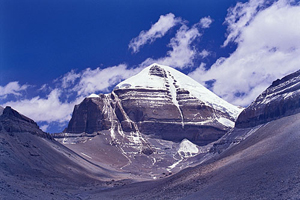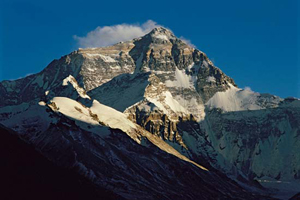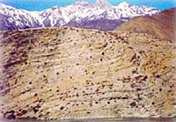
[Assawompset School, Lakeville, Massachusetts]
Himalaya Thematic Unit for Second Grade]
| HOME |
| Introduction |
| Where are the Himalaya? |
| Regions within the Himalaya |
| Poetry and other activities |
| Resources |
Introduction
The beauty, power, and resources of the Himalaya have sparked peoples’ imagination for generations. Mt. Kailash, in Tibet, is one of the most sacred mountains in Asia. People north and south of the Himalaya believe it to be a holy place with the great deities of Tibet and India residing there. Religious pilgrims walk on the plain surrounding Mount Kailash in a kora, or clockwise circumambulation. Monasteries have been built in the Himalaya, where the earth appears to meet the heavens. Mythical creatures, deities, and treasure places create an auspicious environment for three civilizations that converge in the Himalaya: Buddhist monastic tradition from Tibet, the Indic-Hindu cultures from India, and the Islamic societies from the western regions. Westerners, adventurers, and pilgrims are drawn to the trek and visit the Himalaya.

The Himalaya boast ten of the earth’s summits greater than 8,000 meters. The highest mountain, Mt. Everest (called Chomolungma, Goddess Mother of the Earth in Tibet), is approximately 8,850 meters, or about 5 1/2 miles, high. The world’s deepest canyon, the Kali Gandaki Gorge, is also in the Himalayan region. Major rivers, including the Ganges, the Indus, the Yarlung Tsangpo, the Brahmaputra, have their headwaters there.

Geology
Between 40 and 60 million years ago, India was an island that slowly drifted into the Eurasian continent. This collision resulted in huge sections of the Tethys Sea, which was located between India and Asia, being lifted high into a mountain formation. As a result, there are sedimentary rocks on the northern edge of the Himalayas. To this day, seashells, corals, skeletal fish, and ammonites can be found near the summit of Mt. Everest. There is also evidence of rocks that have buckled and folded under the pressure of the geological collision.


Ammonites were sea animals having shells. They resemble a nautilus, but were probably related to the octopus and squid family. When the Tethys Sea disappeared, they became caught in the shale and became fossils. Their spiral shape, reminiscent of the ram’s horns symbolizing the god Vishnu, represents a sacred object for Hindus. Ammonites are called shaligrams in Nepali.
India is still moving at a rate of 2 cm. each year. For this reason, the Himalaya are rising at a rate of 5 millimeters per year. Scientists use a G.P.S. (Global Positioning System) to measure the movement of plates and the rise of the Himalaya. There are survey points throughout the Himalaya. Measurements are taken continuously via satellite.
The Himalaya are one of the youngest mountain ranges on the earth. Geologists call them a high-energy environment. In Nepal alone, which is the most active area, over 1000 earthquakes are recorded each year. The earthquakes and faults along India, China, and Nepal can be attributed to the continued pressure of the India plate moving towards the Eurasian plate more than 3,000 km. away.

Regarded as sacred, mystical, possessing energy and power, the Himalaya offer an interesting focal point for a thematic unit of study about mountains.

